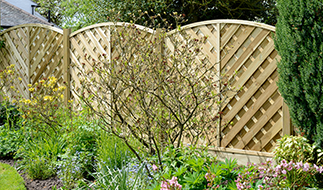Hints & Tips When Painting or Staining Wooden Gates
- Gates
- Railings
- Fencing
- Accessories
& Fitting- Sheds
& Storage- Garden Structures
- Design
& StyleMetal Gates & Railings- Info
& HelpAs with all external timber, if you want it to last then it is essential that it is well protected against the elements otherwise prolonged periods of wet weather can lead to rot and prolonged periods of direct exposure to sunlight will have a tendency to make the timber twists, bow and split.
With this in mind, if you have recently purchased a wooden gate and need to paint or stain it so it remains well protected from the UK weather we have compiled a list of useful tips that are detailed below for you to follow.
Always Stain or Paint the Gates Prior to Installation
To ensure a proper and even coverage of the timber we recommend that all timber gates are stained or painted before they are installed. Not only is this easier and neater but it will actually allow you to cover all the timber surfaces including the underside of the gates where the end-grain of the timber is susceptible to drawing up moisture from the ground.
Paint all the Timber Surfaces at the Same Time
Regardless of whether you choose to paint or stain the timber it is essential that both the front, back, top and bottom of the gate is covered at the same time. If you read the paint/stain manufacturers tin you will probably see this mentioned however they may not tell you why. Well the reason for this is that if you only paint one side and then leave it to dry you run the risk of the timber twisting or warping due to unequal surface tension. In simple terms this mean the side you have not painted will draw the moisture towards it through capillary action which can result in uncontrolled movement of the timber.
Always Follow the Grain of the Wood
When applying your paint or stain never paint across the grain of the wood (otherwise the brush strokes will remain prevalent once dry) and always brush out any drips or runs as these will be impossible to get rid of at a later date and can stand out like a sore thumb. Whilst it may be more time consuming to follow the direction of the grain the results will be far more pleasing to the eye and will actually create better overall coverage.
Don`t Skimp on the Quality of the Preservative
Whilst it may be tempting to find the cheapest stain or paint you can not all of them will offer the same level of protection so we always recommend you choose the most expensive you can afford. Cheap things are cheap for one reason only. They use inferior quality components or will not last as long as higher quality products. If you are staining the gates we recommend you look for a brand that offer UV protection as well as protection against water ingress.
Use a Quality Brush
If you have ever bought a cheap paint brush down at the local DIY store only to find you spend more time removing bristles that painting you will understand where we are coming from with this one. As such avoid these like the plague as they are simply not worth the hassle.
Instead we suggest you purchase a brush that is most suitable for the treatment that you intend to use. This means that if you are using a water based paint select a synthetic brush (as the don’t absorb water) or where an oil based stain or paint is to be used a natural brush will ensure better results.
Apply a Minimum of 2 Coats of Stain or Paint
Whilst it may save you time and effort to only apply a single thick coat of paint or stain to wooden gates you will actually be doing yourself a disservice. Not only will there be a higher risk of drips, run marks and uneven coverage but the level of long term protection you provide will also be drastically reduced.
For this reason we always recommend that any untreated gates are stained or painted with a minimum of 2 coats. It is essential to allow adequate drying time between coats otherwise the finish may become compromised.
In essence, the more time you spend applying a preservative the better the end results will be and the longer the time frame will be between fresh applications.
Don’t Forget About the End-grain of the Timber
Pay special attention to the end-grain of the wood as this will suck up moisture like a sponge if left untreated and will be the first area to show signs of rotting if left in a natural condition.
We hope that you have found the above tips and advice to be of use to you however if you would like to find out more information about our wooden gates including some of our lower maintenance pressure treated options please get in touch by phone or email and we will be available during normal business hours to provide you with any help, advice or assistance you may need.
- Railings



